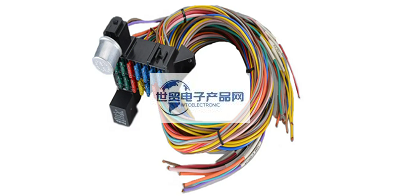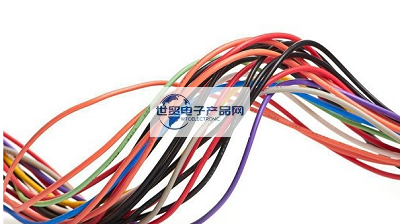Categorization:Product Information
The generation of wire harness ripples is related to the injection parameters, mold and injected material. Generally, there are snake flow mode, radial mode, wave mode and fluorescence mode.
Change the size of the mold gate. When the gate depth is slightly less than the cavity depth, the expansion of the jet outlet will make the melt flow out at the trailing edge and leading edge of the jet, and the jet effect is not obvious. When the gate depth is equal to or close to the cavity depth, the filling rate is low and an expansion flow will form. Change the gate angle of the mold. The angle between the mold gate and the moving mold is 4 ~ 5. In this way, when the molten metal flows out of the gate, the molten metal is first shielded by the cavity wall, which can prevent the occurrence of serpentine. Change the location of the mold gate. The gate of the mold is located closest to the wall of the mold cavity (in a direction perpendicular to the gate). When molten metal flows out of the gate, it is first clogged by the walls of the cavity. It can also prevent the appearance of jets, into extended streams, and avoid winding ripples. 2. When the melt is injected in radial mode, due to the elasticity of the melt, when the melt flows from the cylinder to the cavity through the mold gate, the elastic recovery of the melt will occur. The generation of radial streaks caused by melt fracture occurs rapidly. There are several measures to solve the problem of radial pattern of wire harness. Change process conditions. High-pressure and low-speed injection can increase the flow time of elastic melt under the same flow length, increase the degree of elastic failure and reduce the generation of radial stripes. Change the shape of the door. By enlarging the gate or changing the gate to a scalloped shape, the elasticity of the molten metal can be slightly restored before it enters the cavity, avoiding the molten metal breaking. Extend the length of the main channel of the mold. Before the molten metal enters the cavity, its elasticity fails, which also prevents the cracking of the molten metal. Replace the machine with a long nozzle. Extending the flow path of the melt before entering the mold cavity increases the degree of elastic failure of the melt and also avoids the radial line caused by melt rupture. 3. Wave mode During the melt filling process, new melt flow continues to accumulate from the inside, causing the forward wave to stagnate and the edge of the forward wave to be continuously pulled. Due to the flow resistance, the melt pressure after that rises again. The newly formed corrugations advance smoothly, causing stagnation and buildup, forming a corrugated pattern on the product surface. Especially when the injection speed is fast, the injection pressure is small or the mold structure is unreasonable, the melt flow advances and retreats, and the PP crystallization progresses slowly, which easily leads to uneven crystallinity on the product surface and ripples on the product surface. There are several measures: Changing process conditions. High-pressure and low-speed injection can maintain the stability of melt flow and prevent waves from occurring. Increase the mold temperature. As the mold temperature rises, the melt fluidity increases. For crystalline polymers, higher temperatures are beneficial to the uniformity of crystallization and can reduce the generation of corrugations. Change the cavity structure. Depending on the construction of the mold, the surface of the product may also undulate. When the core edge protrudes, the melt flow rate becomes larger, and the melt flow rate becomes unstable, forming a waveform. Therefore, by changing the angle of the core, the transition can be buffered, the flow of the molten liquid can be stabilized, and the generation of waves in the outer skin of the wire harness can be prevented. Change the thickness of the product. Uneven product thickness will lead to an increase in melt flow rate and unstable melt flow rate. Therefore, the product thickness should be designed as uniformly as possible to avoid corrugation.

-------------------------------------------------------------------------------------------------
4. When the molten metal flows in the cavity in fluorescence mode, one end of the molecular chain close to the solidified layer is fixed on the solidified layer, and the other end is stretched in the flow direction by the adjacent molecular chain. Because the melt flow resistance on the wall close to the mold cavity is the largest and the flow velocity is the smallest, and the flow resistance at the center of the cavity is the smallest and the flow velocity is the highest. This creates a velocity gradient in the flow direction. Therefore, the injection speed is small, the injection pressure is high, or the product thickness is large. When it is thin, the melting shear force near the cavity wall is the strongest, the degree of orientation is the largest, and the polymer is stretched in the flow, showing internal stress. There are the following countermeasures: changing the process conditions. At medium pressure and medium speed injection, with the increase of injection speed, the melt cooling time decreases at the same branch length, the melt solidification per unit volume is relatively slow, the internal stress of the product weakens, and the product surface decreases. Appears on fluorescent signs. Increase the mold temperature. Higher mold temperature can accelerate the relaxation of macromolecules, reduce molecular orientation and internal stress, and reduce the appearance of fluorescent stripes on the product surface. Change the cavity structure and increase the product thickness. The product thickness is large, the melt cools slowly, the stress relaxation time is relatively prolonged, the orientation stress is reduced, and the fluorescence stripes are reduced. Heat treatment (roasted in the oven or boiled in hot water. The heat treatment enhances the motion of the polymer, shortens the relaxation time, enhances the de-orientation effect and reduces the fluorescent stripes. There are several countermeasures as follows: Change process conditions. At medium pressure and medium speed injection, with the increase of injection speed, the melt cooling time decreases at the same branch length, the melt solidification per unit volume is relatively slow, the internal stress of the product weakens, and the product surface decreases. Appears on fluorescent signs. Increase the mold temperature. Higher mold temperature can accelerate the relaxation of macromolecules, reduce molecular orientation and internal stress, and reduce the appearance of fluorescent stripes on the product surface. Change the cavity structure and increase the product thickness. The product thickness is large, the melt cools slowly, the stress relaxation time is relatively prolonged, the orientation stress is reduced, and the fluorescence stripes are reduced. Heat treatment (roasted in the oven or boiled in hot water. The heat treatment enhances the motion of the polymer, shortens the relaxation time, enhances the de-orientation effect and reduces the fluorescent stripes.

---------------------------------------------------------------------------------------------------------------------------------------------------------------------------------------------------------------------------------------------------------------------------------------------------------- If you have related [connector wiring harness and cable products] purchasing/purchasing needs or want to purchase/understand which connector wiring harness and cable product solutions we can provide, please contact our business staff below; If you have related [Connector Wiring Harness Cable Products] sales/resources and promotion needs, please click "→ Business Cooperation ←" to negotiate with a dedicated person!